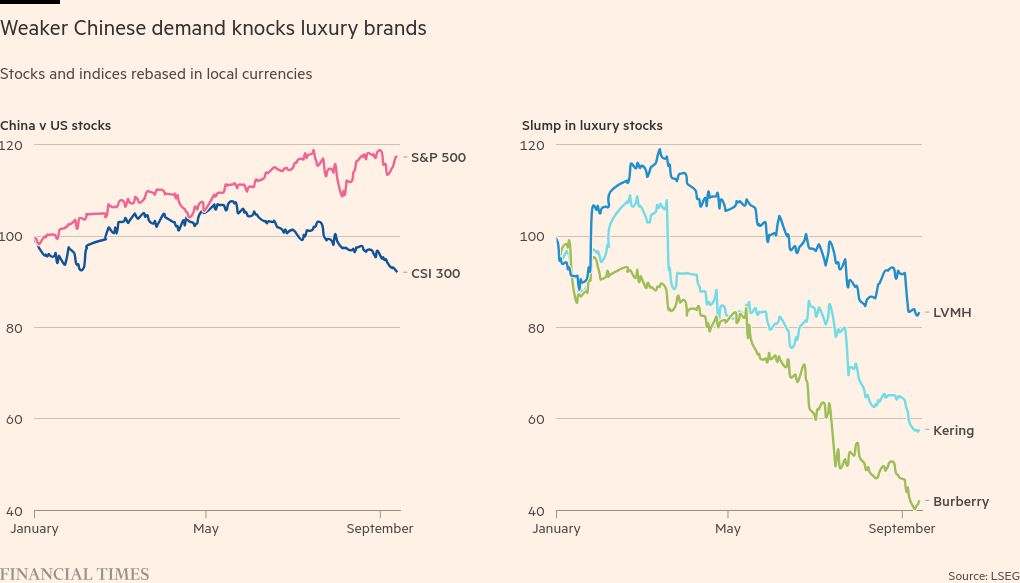
Unlock the Editor’s Digest for free
Roula Khalaf, Editor of the FT, selects her favourite stories in this weekly newsletter.
Investors generally agree that the dark clouds building over the US economy and the apparent cooling of the rush to buy whizz-bang tech stocks are painful on the one hand, but great news for some previously overlooked companies and for markets outside the US on the other.
The shift has encouraged investors to take another look at Europe, the UK, Japan and other markets. But one market that is not on the global shopping list for this so-called broadening trade, nowhere close to it in fact, is China.
US stocks have come off the boil, for sure. But in the year so far, the benchmark S&P 500 index is still up by 18 per cent. China, meanwhile, is in a deep hole. The CSI 300 index has fallen by about 7 per cent this year. The pain is not confined to Chinese markets, however. Take a look around at all the European stocks that are treated as proxies for the Chinese economy, particularly in luxury, and it is pretty grim out there.
Analysts at Barclays took a visit to luxury stores and malls in China to see what was going on for themselves (the definition of a tough assignment). The trip did not exactly bolster their confidence.
“Reality check, it’s worse than we thought,” they wrote in conclusion in a note to clients this week. “We have returned incrementally more cautious on the sector, as China now looks weaker for longer on structural issues . . . The luxury pie is barely growing.”
As a result, the bank downgraded several European luxury companies — one of investors’ favoured bets on China outside of the domestic market. That includes Gucci owner Kering, which has already fallen 40 per cent this year. Barclays reckons the share price could fall more than another 10 per cent, to €210. Burberry, which has fallen even harder this year — the stock is down 58 per cent — is also in line for a further 8 per cent decline to £5.40, the bank warned.
“After an already challenging first half in mainland China, feedback from our trip suggests either similar or deteriorating trends in July and August as most brands were down by 10 per cent to 50 per cent,” the bank wrote.
Earlier this year, the received wisdom was that China’s problem was housing. A real estate building bubble burst, leaving behind enormous overcapacity and lots of overly indebted property developers, and denting household wealth in the process. That was grim for people caught in the middle of it, but investors generally believed it would pass as soon as the state managed to inject confidence back into the sector.

But this confidence has proven elusive. Instead, problems are wider ranging. Official data shows that annual inflation is running well under 1 per cent, and nervy households are hoarding cash. Economists are calling on Chinese authorities to launch a “shock and awe” stimulus package to try to turn fortunes around.
It would be unwise to expect that quickly. Sentiment among Chinese investors is “extremely pessimistic”, research house TS Lombard wrote this week. But Chinese President Xi Jinping’s “pain tolerance” is high, analyst Rory Green said, suggesting state help may be lacking at least until early next year.
One thing in favour of Chinese stocks is that they are cheap, trading on an average price/earnings ratio of about 11 times. But, as Peter van der Welle, a multi-asset strategist at Robeco said at a presentation this week, they are not cheap enough. The recovery of the housing market — a huge input in to the overall economy — appears to be following previous patterns from the US or Spain, he said. “That implies it will still take a couple of years for a bottoming out,” he said. “We could be close to a trough in Chinese equities because markets will anticipate that. But we’re not there yet.”
In the meantime, investors are often happy to avoid the market entirely. “The investment case to buy China is totally, totally dead,” said Vincent Mortier, group chief investment officer at Europe’s largest asset manager, Amundi.
“No one is interested in buying Chinese assets. I have never seen such a big pushback among all our clients,” he said. The economic environment is already grim, he said, consumers are reluctant to spend, and trade tariffs from the US are likely to step up further regardless of who wins the US presidential election. If Donald Trump manages to ascend back to the White House, those tariffs could be brutal.
Many investors are seeking to harness the chance of a Chinese comeback through a mix of Indian and Japanese stocks, he said — a “short-cut” tactic of which he is not a fan. A year or two ago, Mortier himself was in favour of buying European auto and luxury stocks, among others, as a way to bet on China without the onshore regulatory risks. But even there, he is more cautious now.
Over the long term, he said, China will at some point bounce back. It makes a lot of sense to have at least a small allocation to it in a broader portfolio so investors can catch that upswing from the start. “You should never underestimate its importance to the global economy,” he said. “It’s a nice strategy for the long term. But today it’s impossible to convince our clients.”